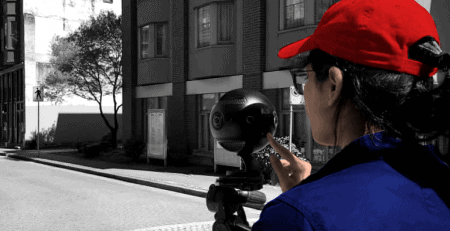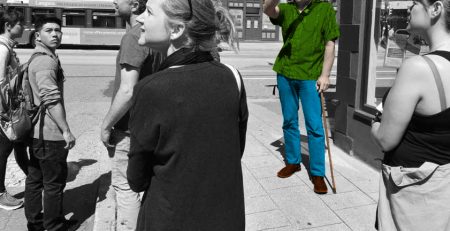The Bellingham “Anti-Hindu Riot”
By Paul Englesberg
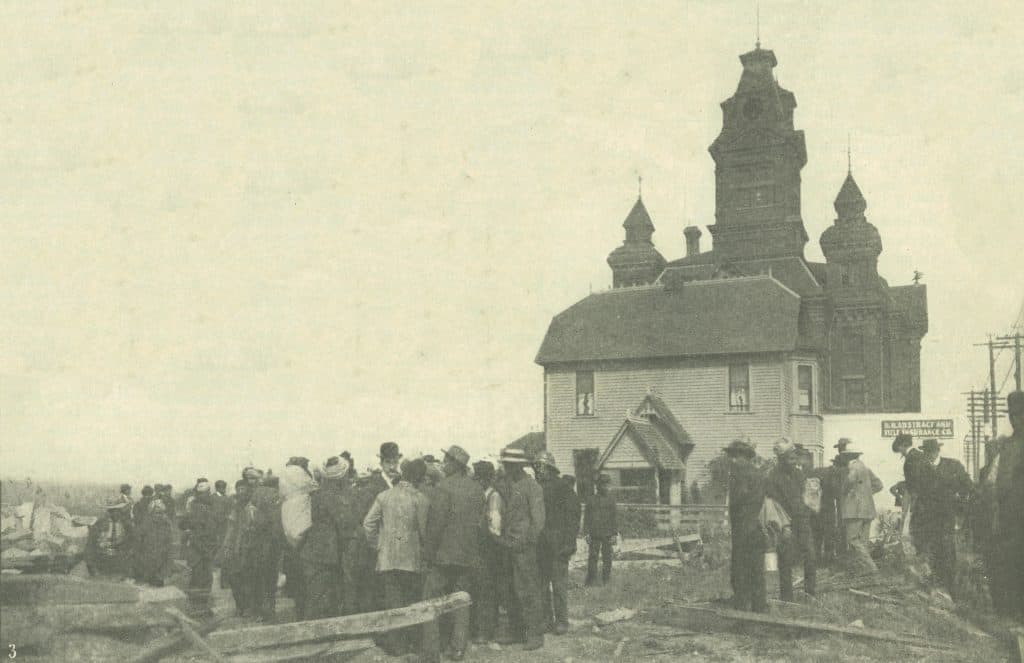
Photo source: Colliers, Sept. 28, 1907. Caption from Dodd, W.D. “The Hindu in the Northwest.” World Today, vol. 13, 1907.
On the evening of September 4, 1907 in Bellingham, Washington, a mob attacked and drove out several hundred immigrant laborers from India, referred to commonly as “Hindus.” In fact, most of these immigrants were Sikhs from the Punjab region. The goal of the rioters was to force the South Asian workers from the lumber mills and the city, using beatings and the threat of force to round up the men from their beds and mills. Overnight over a hundred were herded into the city jail in the basement of City Hall upon an agreement worked out with the police chief. Within a few days the goals of the mob were fulfilled; nearly all of the South Asian workers and job-seekers had either left by train or steamship for points further south along the Pacific coast or on foot to cross back into Canada. Several of the South Asian workers were beaten, and according to spokesmen for the group, many took the threats seriously and were afraid for their lives. Although the local papers downplayed the injuries, six were badly beaten and hospitalized according to a disputed wire dispatch (New York Times, Sept. 5, 1907).
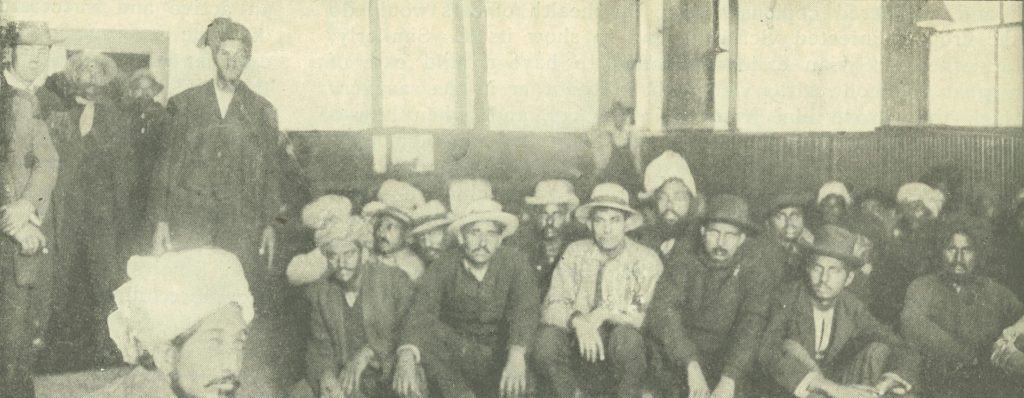
THE TWO HUNDRED HINDU PRISONERS: The room in which they were confined by the mob during the night
Photo source: Colliers, Sept. 28, 1907. Caption from Dodd, W.D. “The Hindu in the Northwest.” World Today, vol. 13, 1907.
The rioters were said to number at least 500, and accounts describe a mob that grew and separated into groups through the night, some attacking living quarters and other marching to lumber mills. Five men were arrested and jailed and police handcuffed two others described as boys but released them when surrounded by a mob. The five arrested rioters were later released and never indicted due to the prosecutor’s claim that no witnesses could be found willing to testify (Bellingham Herald, Sept. 21, 1907, p. 8).
The action was the first in a series of attacks on “Hindus” in Washington State and British Columbia, but it was not the first anti-Asian action in the Bellingham area. In October 1885, an anti-Chinese movement expelled the Chinese residents from the towns that would later combine to form Bellingham. There was a series of warnings and attacks in the days before the 1907 riot. After a massive Labor Day parade and gatherings of workers, labor leaders issued threats, and several violent incidents against immigrants from India broke out (Bellingham Reveille Sept. 6, 1907, p. 1).
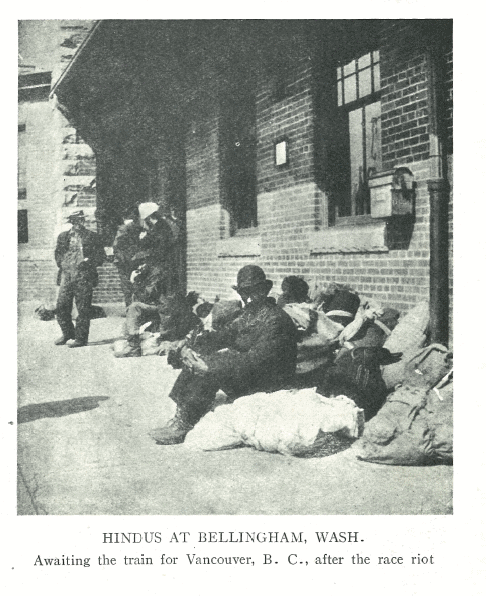
Fears of invasion and hostility arose as South Asian immigrants began to arrive in the Bellingham area in early 1906, a year preceding the riot, when approximately 20 South Asians were working in lumber mills and on a street paving project, some millworkers demanded they be fired, and the press raised fears of a “dusky peril.” (Puget Sound American, Sept. 16, 1907, p. 16). City arrest records suggest a pattern of police harassment and discriminatory treatment.
A.E. Fowler, the secretary of the Seattle branch of the Asiatic Exclusion League arrived in Bellingham on September 6, on his way to Vancouver, B.C. where he spoke at the large exclusionist meeting the next day. Some Canadians blamed his impassioned speech, in which he invoked the Bellingham riot, for sparking the violence in Vancouver.
After the Bellingham riot, press reports identified both immediate and long-standing grievances that were attributed as causes. Primary were economic threats to mill jobs and wages, as the South Asian laborers were believed to be willing to work for lower wages than the prevailing rate for European Americans, therefore taking jobs from others. A further complaint was that the immigrant workers spent little, lived very frugally, and saved much of their pay to send to family in India. Immediate grievances mentioned as triggering the violence were several South Asian men refusing to yield the sidewalk to women, boisterous fighting outside of taverns, and a white female tenant being displaced by “Hindu” men. The lumber mill owners who employed the South Asian workers were named as the ultimate culprits by the Bellingham City Council in a controversial resolution (Bellingham Herald, Sept. 10, 1907). By September 17, the last few remaining residents from India were evicted, and for many decades most people from South Asia avoided Bellingham and Whatcom County. It was not until the late 1980s and 1990s that some Sikh families began to move to the area, and today the Punjabi Sikh community in Whatcom County has grown to about 4,000 people.
Sources
Print Resources and Historical Documents
- Bellingham Riot Documents Collection. South Asian American Digital Archives [SAADA] https://www.saada.org/subject/bellingham-riot
- Cahn, D. (2008). The 1907 Bellingham Riots in Historical Context. . Seattle Civil Rights and Labor History Project, University of Washington. https://depts.washington.edu/civilr/bham_history.htm
- Englesberg, P. (2015). The 1907 Bellingham Riot and Anti-Asian Hostilities in the Pacific Northwest. https://scholarworks.waldenu.edu/cel_pubs/62/
- Seattle Civil Rights and Labor History Project, University of Washington. 1907 Bellingham Riots. https://depts.washington.edu/civilr/bham_intro.htm
Videos
- Creigh, S.(2013). We Are Not Strangers. https://www.youtube.com/watch?v=mvn_LpXj694
- Hedden, A. & Morgan, I.(2007). Present in All That We Do. https://depts.washington.edu/civilr/film_present_all.htm
- Racial Justice Coalition & Cerritti, J. (2018) Colonizing and Decolonizing History Tour of Bellingham. https://www.youtube.com/watch?v=EWNAZVfEO3s
- Systemic Racism Project, Western Washington University (2019). Bellingham Walking Tour: Exploring Systemic Racism.
Overview:https://wp.wwu.edu/timeline/walking-tour/
Video: https://storymaps.arcgis.com/stories/a6734c6db7ec467790fa08eede946efe - Scroll.in, Violence and Terror for Indian Mill Workers. https://scroll.in/video/848934/watch-on-this-day-in-1907-indian-immigrants-in-washington-were-attacked-by-an-angry-mob
- Arch of Healing and Reconciliation. [Three short videos]
City of Bellingham, https://www.youtube.com/watch?v=nI33qeYCs4c
City of Bellingham, https://www.youtube.com/watch?v=CMGUM6ndMWM
Bellingham Herald,https://www.youtube.com/watch?v=nI33qeYCs4c
About the author
Paul Englesberg is writing a book about immigrants and conflict in the Pacific Northwest.

